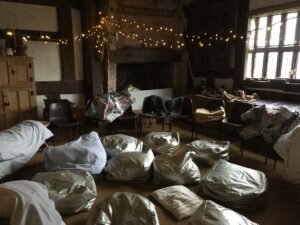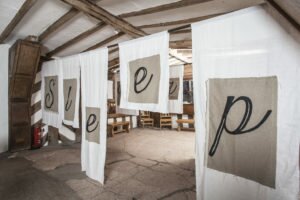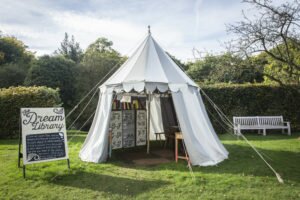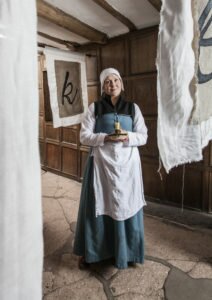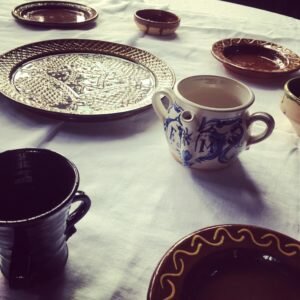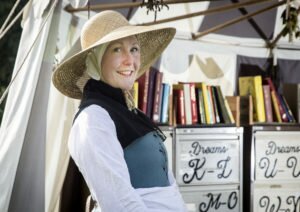 As we’ve reached the end of our year-long project, ‘How We Used to Sleep’, it seems like a good time to take stock of what we have achieved at Little Moreton Hall. The aim of our events and activities was to translate Dr Sasha Handley’s research into early modern sleep into an engaging range of activities, events, talks, training and educational materials for our staff and for the wider public. We wanted to see if we could spend some time in the shoes (or bedclothes) of the people who lived at Little Moreton Hall in the sixteenth and seventeenth centuries, to see if we could understand more about what they believed and the practices they followed and whether we could actually pick up some good tips about how to live well and sleep better.
As we’ve reached the end of our year-long project, ‘How We Used to Sleep’, it seems like a good time to take stock of what we have achieved at Little Moreton Hall. The aim of our events and activities was to translate Dr Sasha Handley’s research into early modern sleep into an engaging range of activities, events, talks, training and educational materials for our staff and for the wider public. We wanted to see if we could spend some time in the shoes (or bedclothes) of the people who lived at Little Moreton Hall in the sixteenth and seventeenth centuries, to see if we could understand more about what they believed and the practices they followed and whether we could actually pick up some good tips about how to live well and sleep better.
We started the year by inviting our artist friends at Wild Rumpus to design our Sleep Trail and Dream Tent. The Trail, later installed at Little Moreton Hall, took you through a night of Tudor sleep. Our Dream Tent housed a surreal library of early modern and contemporary dreams. Wild Rumpus co-designed the Sleep Trail and Dream Tent during a workshop with a group of volunteer families in February, exploring what they thought about sleep and the nature of their bedtime routines. The workshop finished with the construction of a ‘sleep den’ where we all got cosy and chatted about the importance of sleep.
Via a succession of art installations exploring different aspects of Sasha Handley’s research, one could navigate a Tudor night’s sleep through linen bedsheets, smell Alice in Wonderland-esque flasks full of strange, soporific potions, meet evil spirits, try segmented sleep, settle back down to bed for your ‘second sleep’ and wake up to a natural sunrise. At each point visitors could learn about each unique aspect of early modern sleep, get a feel for what nighttime was like in Tudor times and pick up tips from 500 years ago. Check back on the site soon for our digitised version.
Here you could add your weird and wonderful dreams to our dream library collection, rifle through filing cabinets to marvel (or just laugh) at other people’s, and learn not only about what the Tudors dreamed of but what they thought it all meant. Again, experience a digitised version here soon with samples of dreams and guides to Tudor dreams and interpretations.
The Tudors celebrated the festival of Candlemas each February. Candlemas was effectively a festival of light that welcomed its return after a long winter of darkness. To mark this festival we made beeswax candles with our visitors and explored some of the other lighting technologies that would have been used by the Tudors. We imagined what it would have been like to spend a night at Little Moreton Hall and just how dark it would have been without electricity or street lighting. We compared wax candles to tallow/fat candles, oil lamps, lanterns and rush lights. This was a good place to start when thinking about why the Tudors had a different attitude towards night-time and towards sleep. The night was believed to bring many dangers.
Textiles
Closely linked to night-time fears was the urge to protect the body from danger through the use of particular kinds of bedding. In March, Little Moreton Hall’s embroidery team started to make a linen coif (a woman’s close-fitting cap) and nightcap, which would have been worn in bed. The team had previously embroidered two linen pillowcases. To celebrate this work, 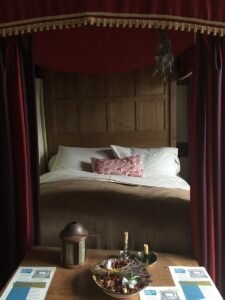 an embroidery exhibition was held at the Hall, which gave us the opportunity to explore why textiles were so important to early modern sleeping habits. Linen is a cooling fabric that was thought to control body temperature at night. It is also robust and easy to launder and so made it easier to sleep well in a clean bedstead. Nightcaps and coifs also helped to control body temperature and they were often finely embroidered. The use of embroidered designs may have offered reassurance at bedtime: natural flora and fauna perhaps helped to relax the sleeper, whilst religious imagery may have reassured them. Adding the name or initials of family members to bedding also introduced an element of personalisation into the sleeping chamber, allowing the sleeper to be surrounded by objects that reminded them of loved ones as night-time approached. Visitors to the Hall could watch the embroidery team at work as well as join in with their own blackwork embroidery and touch fabrics and designs to feel the tactile sensations that were also reassuring in the dark.
an embroidery exhibition was held at the Hall, which gave us the opportunity to explore why textiles were so important to early modern sleeping habits. Linen is a cooling fabric that was thought to control body temperature at night. It is also robust and easy to launder and so made it easier to sleep well in a clean bedstead. Nightcaps and coifs also helped to control body temperature and they were often finely embroidered. The use of embroidered designs may have offered reassurance at bedtime: natural flora and fauna perhaps helped to relax the sleeper, whilst religious imagery may have reassured them. Adding the name or initials of family members to bedding also introduced an element of personalisation into the sleeping chamber, allowing the sleeper to be surrounded by objects that reminded them of loved ones as night-time approached. Visitors to the Hall could watch the embroidery team at work as well as join in with their own blackwork embroidery and touch fabrics and designs to feel the tactile sensations that were also reassuring in the dark.
Sleep Bed
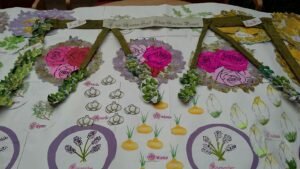 In April we planted our sleep bed, the area of the garden given over exclusively to growing sleepy ingredients to use in our historic sleep remedies at Little Moreton Hall. Our friends at Carter House Day Centre in Congleton helped to sow seeds, bed plants, and build two trellises. Whilst planting, they learned about Tudor attitudes to sleep, health, life balance and wellbeing and specifically how particular herbs, plants, vegetables and flowers were used to help people relax and sleep well, which was judged essential to physical and mental health. The adults at Carter House put all they’d learned into their colourful design of the sleep bed at Little Moreton Hall. Our gardener, Natalie, used the design to plan the sleep bed and she helped to create a second, smaller sleep bed at Carter House for our friends to use in the future.
In April we planted our sleep bed, the area of the garden given over exclusively to growing sleepy ingredients to use in our historic sleep remedies at Little Moreton Hall. Our friends at Carter House Day Centre in Congleton helped to sow seeds, bed plants, and build two trellises. Whilst planting, they learned about Tudor attitudes to sleep, health, life balance and wellbeing and specifically how particular herbs, plants, vegetables and flowers were used to help people relax and sleep well, which was judged essential to physical and mental health. The adults at Carter House put all they’d learned into their colourful design of the sleep bed at Little Moreton Hall. Our gardener, Natalie, used the design to plan the sleep bed and she helped to create a second, smaller sleep bed at Carter House for our friends to use in the future.
To coincide with this, visitors to the hall made seed bombs filled with sleep-inducing flower and herb seeds so that they could have their own piece of the sleep garden at home or ‘seed bomb’ a waste piece of ground with some colourful and calming soporific plants.
Dairying
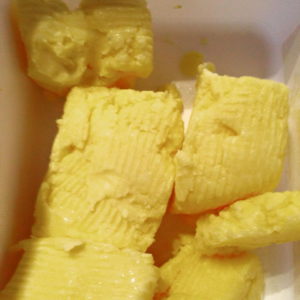 May would mark the start of the year’s dairy season. Churning butter is hard work and certainly, after a whole day of it, our interpreters had no problem dropping off to sleep! Tudor ideas about sleep were heavily linked to digestion. Dairy products played an important role in ensuring the process of digestion, and thereby sleep, went well. Heat intensified in the stomach during the night (one reason why sleep remedies usually involved some cooling of the body’s extremities) and the food inside would bubble away as though it was in a cooking pot. This cooking up of the stomach’s contents (‘concoction’) meant that vapours evaporated up off the food and rose up to the brain. These moistened and relaxed the brain and caused the sleeper to rest soundly. After the vapours condensed in the brain they were also distributed around the body to refresh its parts. By starting a meal with lighter foods, pottage (soup) and salads, followed by heavier meats, and ending with something light that sealed the stomach with a dairy ‘lid’ of cheese or butter, the process of concoction was believed to work better and improve sleep. Perhaps this is why some people still like to finish a meal with a cheese board today.
May would mark the start of the year’s dairy season. Churning butter is hard work and certainly, after a whole day of it, our interpreters had no problem dropping off to sleep! Tudor ideas about sleep were heavily linked to digestion. Dairy products played an important role in ensuring the process of digestion, and thereby sleep, went well. Heat intensified in the stomach during the night (one reason why sleep remedies usually involved some cooling of the body’s extremities) and the food inside would bubble away as though it was in a cooking pot. This cooking up of the stomach’s contents (‘concoction’) meant that vapours evaporated up off the food and rose up to the brain. These moistened and relaxed the brain and caused the sleeper to rest soundly. After the vapours condensed in the brain they were also distributed around the body to refresh its parts. By starting a meal with lighter foods, pottage (soup) and salads, followed by heavier meats, and ending with something light that sealed the stomach with a dairy ‘lid’ of cheese or butter, the process of concoction was believed to work better and improve sleep. Perhaps this is why some people still like to finish a meal with a cheese board today.
Ceramics
Having the right equipment was vital to make the food you ate, or the remedies you made to secure sound sleep. Here, ceramics were crucial. Our costumed interpreters at Little Moreton Hall have amassed an extensive collection of tableware, stills, dishes, jugs, tygs, gallipots and fuming pots over the years and so it was great to see them all displayed in one place with our ceramics exhibition , which ran throughout May and June. The Tudors used these ceramic pieces to facilitate a good night’s sleep. Our board (long table) in the Great Hall was set with tableware with advice on what foods to consume and which to avoid as bedtime approached. Our Great Parlour table was set ready for the consumption of the various candies and sweetmeats said to bring on sleep, and our Activity Room was filled with still-room equipment that was used by the ladies of the Hall to make sleep remedies for the whole family and to keep the evening air sweet-smelling, fumigated and conducive to sleep.
Remedies:
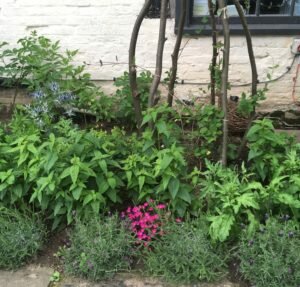 By June our sleep garden was in full bloom. In our Activity Room we used our ceramic replicas to make sleep remedies with visitors. This was good, messy fun. We dried out ingredients from our sleep bed, ground ingredients for sleepy poultices to apply to our foreheads, made herbal sleepy infusions and nightcaps containing poppy seeds and wine, preserved rose and violet petals with sugar and stuffed fennel seeds and rose water bags near our noses to clear the head and calm the mind. That plus sweet bags filled with lavender, rose, chamomile and hops meant that the Hall smelled amazing and we were all very calm, relaxed and, dare we say it, drowsy by the end of each day! See more details of what we’ve been making – click here for remedy recipes
By June our sleep garden was in full bloom. In our Activity Room we used our ceramic replicas to make sleep remedies with visitors. This was good, messy fun. We dried out ingredients from our sleep bed, ground ingredients for sleepy poultices to apply to our foreheads, made herbal sleepy infusions and nightcaps containing poppy seeds and wine, preserved rose and violet petals with sugar and stuffed fennel seeds and rose water bags near our noses to clear the head and calm the mind. That plus sweet bags filled with lavender, rose, chamomile and hops meant that the Hall smelled amazing and we were all very calm, relaxed and, dare we say it, drowsy by the end of each day! See more details of what we’ve been making – click here for remedy recipes
Later in the summer holidays we had more fun making sleep remedies. We learned how to candy, crystallise, conserve and preserve soporific ingredients, seeing how effective we think a Tudor posset would be (curdled custard bedtime drink anyone?) and looking at the process of distillation. We discussed our own ways of getting sleepy at bedtime and made the most of the sleep garden at its most potent peak.
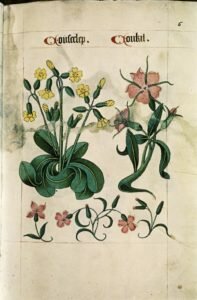
Embroidery Projects
Our embroiderers had been eager to keep their hands busy and so they started work planning a wall hanging over the summer that will hopefully go alongside our other furnishings in our bedchamber. As Sasha Handley points out, the majority of household textiles centred on the best bedchambers, and they helped families to feel cosy and secure as they drifted off to sleep. The hanging includes lots of floral designs and motifs taken from old medical herbals (botanical illustrations) of the period, together with religious imagery that would have been meaningful to the family as they begged for God’s protection in their bedside prayers. We can use the hanging as a way of opening up conversations with visitors about the four humours and the six non-natural things over the coming years since the sleep project has inspired our interpretation programme in the years ahead.
We also began working with the Art Society at Dane Valley on a bedspread that will incorporate similar floral motifs alongside personalised patches where the Moreton fam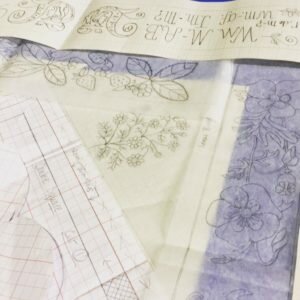 ily’s births, marriages and deaths will be commemorated. The embroiderers from the Art Society are working with the Moreton family tree to select and include names from the family’s past. Again, having family names and lost loved ones commemorated on bedding in this way may have helped to comfort sleepers, surrounding them with happy reminders of loved ones. We hope to begin displaying the first section of our bedspread in the New Year as part of the project’s ongoing legacy.
ily’s births, marriages and deaths will be commemorated. The embroiderers from the Art Society are working with the Moreton family tree to select and include names from the family’s past. Again, having family names and lost loved ones commemorated on bedding in this way may have helped to comfort sleepers, surrounding them with happy reminders of loved ones. We hope to begin displaying the first section of our bedspread in the New Year as part of the project’s ongoing legacy.
Tudor Childhood and Bedtime Routines
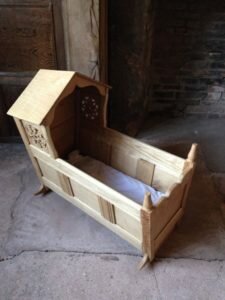 In July we recreated the daily routines of a Tudor child. From waking up to going to sleep, from education to on-the-job training, from table manners to childhood games, from the cradle to the sick bed, we experienced what it was like to be a child in early modern England and how the principles of the four humours and the six non-natural things affected every area of your life and routine. We looked at the theories behind a child’s daily activities including waking and retiring times, personal hygiene, food consumption, learning how to make medicines and look after your health and what children would do for recreation and to unwind before bed including games and finger-loop braiding. We also explored bedtime rituals up in the bedchamber and compared them to children’s sleep routines today to see if we could pick up some useful sleep tips. See the link to compare the two including tips from our friends The Children’s Sleep Charity click here.
In July we recreated the daily routines of a Tudor child. From waking up to going to sleep, from education to on-the-job training, from table manners to childhood games, from the cradle to the sick bed, we experienced what it was like to be a child in early modern England and how the principles of the four humours and the six non-natural things affected every area of your life and routine. We looked at the theories behind a child’s daily activities including waking and retiring times, personal hygiene, food consumption, learning how to make medicines and look after your health and what children would do for recreation and to unwind before bed including games and finger-loop braiding. We also explored bedtime rituals up in the bedchamber and compared them to children’s sleep routines today to see if we could pick up some useful sleep tips. See the link to compare the two including tips from our friends The Children’s Sleep Charity click here.
RHS Tattton Flower Show and Just So Festival with Wild Rumpus
The ‘How We Used to Sleep’ project went on the road over the summer. At the end of July our Dream Library and Sleep Bed visited the RHS Tatton Flower Show to show people how their garden produce can help influence their sleep and dreams. This was also an opportunity to tell people about our aim for the garden at Little Moreton Hall to become more of a working garden, utilised in the same way as it would have been by our family in the sixteenth century.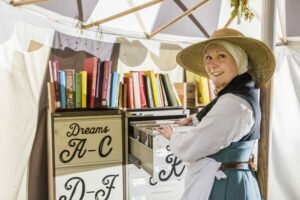
At the end of August our entire Dream Tent set off for the magical Just So Festival (organised by our friends at Wild Rumpus). Fitting in perfectly, we entered a surreal world of Tudor dreams.Over the course of the weekend our collection of dreams doubled in size, allowing the dream tent to show a real snapshot of dreams in times past and present. There is nothing new under the sun when it comes to what we regularly dream about: fairies, flying, teeth falling out – all the usual dreams appeared then as they did now with people at the festival. People could try their hand at interpreting their dreams using the techniques and understandings of the past which was interesting to say the least!
The Tudor Group at Little Moreton Hall – Putting the Hall to Bed
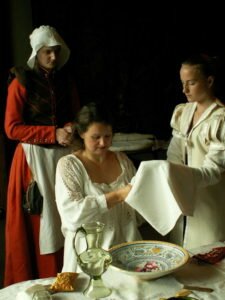 On Saturday 12 August another of our project partners, The Tudor Group, added their expertise to the programme. They played the part of the Moreton family and their servants as they retired for the night: finishing their meal, taking a turn of the garden, preparing their bodies and bedchambers for sleep, chopping wood for the fires, ejecting strangers, locking up the house and stuffing their straw mattresses with soporific herbs. Entry was free, with the Hall opened from 6-9pm. The event was a rare chance to see the hall in the evening as dusk fell. Visitors could wander and discover different people going about their bedtime routine with the group giving commentaries on what was happening at each stage of the experience.
On Saturday 12 August another of our project partners, The Tudor Group, added their expertise to the programme. They played the part of the Moreton family and their servants as they retired for the night: finishing their meal, taking a turn of the garden, preparing their bodies and bedchambers for sleep, chopping wood for the fires, ejecting strangers, locking up the house and stuffing their straw mattresses with soporific herbs. Entry was free, with the Hall opened from 6-9pm. The event was a rare chance to see the hall in the evening as dusk fell. Visitors could wander and discover different people going about their bedtime routine with the group giving commentaries on what was happening at each stage of the experience.
Talks:
As part of our community involvement, we gave talks and ran workshops with various groups throughout the year including the Women’s Institute, the Arts Society, Macclesfield Eye Society, Carter House Day Centre, schools and other National Trust property teams including The Tudor Merchant’s House in Tenby. Participants could make sleepy sweet bags filled with soporific pot pourri, have a go at making sleep remedies, interact with still room equipment, discuss their own bedtime routines and Tudor bedtime tips, make ‘tussie mussie’ posies with ingredients from the sleep garden, learn more about the theory of the four humours and six non-natural things and see how all of these things have helped us to think more like a Tudor about sleep, health, balance and wellbeing.
Food Preservation:
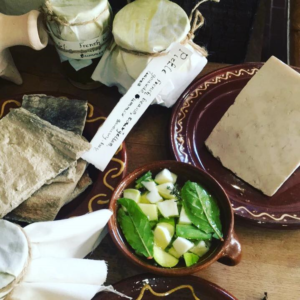 In September, our thoughts turned to food preservation and how to prepare and store all the sleepy ingredients that were still coming in from the garden. This was an important time of year for the Tudors as they worked hard throughout the autumn filling their stores ready for the long winter. It would be as important to ensure you had a supply of remedies during these lean months as it would to make sure you had enough to eat. Visitors could harvest the plants and herbs from the garden, help us make rose and violet conserves, take part in the last of the dairying, pickle vegetables, candy and crystallise flower petals and find out the best methods for the preservation of fish and meat. It was also a great opportunity to learn more about recommended sleepy foods to try today and about how the theory of the four humours and humoral balance affected what you were supposed to eat and types of food to avoid. Plants and foodstuffs had their own humoral designations just as people themselves did. Eating the wrong thing for your temperament could lead to all kinds of health problems not to mention affecting your sleep. [click here for more information and recipes].
In September, our thoughts turned to food preservation and how to prepare and store all the sleepy ingredients that were still coming in from the garden. This was an important time of year for the Tudors as they worked hard throughout the autumn filling their stores ready for the long winter. It would be as important to ensure you had a supply of remedies during these lean months as it would to make sure you had enough to eat. Visitors could harvest the plants and herbs from the garden, help us make rose and violet conserves, take part in the last of the dairying, pickle vegetables, candy and crystallise flower petals and find out the best methods for the preservation of fish and meat. It was also a great opportunity to learn more about recommended sleepy foods to try today and about how the theory of the four humours and humoral balance affected what you were supposed to eat and types of food to avoid. Plants and foodstuffs had their own humoral designations just as people themselves did. Eating the wrong thing for your temperament could lead to all kinds of health problems not to mention affecting your sleep. [click here for more information and recipes].
Trust New Art – The Dreamer is Still Asleep
Artist Robin Rimbaud, aka Scanner, was commissioned by the ‘Trust New Art’ programme to develop a sound  installation mimicking the typical soundscape someone sleeping at the Hall might have experienced in the early modern period. If the walls could talk, what would they tell us? The sound piece, installed from the end of July to the end of October allowed us to experience the Hall from a completely different sensory perspective. From the surreal to the sleepy, the disturbing to the dreamlike, the soundtrack explored the drifting, liminal space between wakefulness, dreams and sleep. See our interview and short film with Scanner here Scanner – The Dreamer is Still Asleep.
installation mimicking the typical soundscape someone sleeping at the Hall might have experienced in the early modern period. If the walls could talk, what would they tell us? The sound piece, installed from the end of July to the end of October allowed us to experience the Hall from a completely different sensory perspective. From the surreal to the sleepy, the disturbing to the dreamlike, the soundtrack explored the drifting, liminal space between wakefulness, dreams and sleep. See our interview and short film with Scanner here Scanner – The Dreamer is Still Asleep.
Hallowtide – Things That Go Bump In The Night
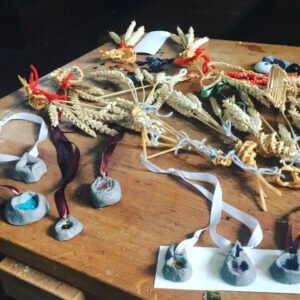 We drew our year of Tudor sleep to a close by thinking once more about those dark, long, winter nights that are just around the corner. How did the Moretons, and their contemporaries, feel about Hallowtide (Halloween)? We discussed the dangers that the night was thought to bring, and looked at how and why people used charms, gem stones, pictures and candle magic to protect themselves from evil spirits. Children listened to some favourite bedtime stories in the bedchamber and brought their teddies along with them to tell us what they couldn’t sleep without. We learned how the Tudors tried to feel safe in the dark, well defended against those evil spirits that lurked in the shadows.
We drew our year of Tudor sleep to a close by thinking once more about those dark, long, winter nights that are just around the corner. How did the Moretons, and their contemporaries, feel about Hallowtide (Halloween)? We discussed the dangers that the night was thought to bring, and looked at how and why people used charms, gem stones, pictures and candle magic to protect themselves from evil spirits. Children listened to some favourite bedtime stories in the bedchamber and brought their teddies along with them to tell us what they couldn’t sleep without. We learned how the Tudors tried to feel safe in the dark, well defended against those evil spirits that lurked in the shadows.
What a year! Good job we’ve all been sleeping really well isn’t it? Though the project is now at an end, you can still find out more in the coming weeks about our future plans at the Hall and at the University of Manchester regarding early modern health, wellbeing and emotions, explore the project’s legacy, visit our online versions of the sleep trail and dream tent, see our latest films documenting the year, use our teaching resources and view our photo gallery. We’ve learned a lot about sleep and its importance for health and wellbeing and we hope that you have too.
Links:
https://www.nationaltrust.org.uk/little-moreton-hall
http://www.wildrumpus.org.uk/
http://www.justsofestival.org.uk/
http://www.thechildrenssleepcharity.org.uk/
https://ice.cheshireeast.gov.uk/Services/792/Carter-House-Day-Cen
https://www.tudorgroup.co.uk/
https://www.nationaltrust.org.uk/features/trust-new-art-exhibitions-and-events
https://www.rhs.org.uk/shows-events/rhs-flower-show-tatton-park
https://theartssociety.org/societies/welcome-arts-society-dane-valley
https://www.nationaltrust.org.uk/tudor-merchants-house
http://www.macclesfieldeyesociety.org.uk/
